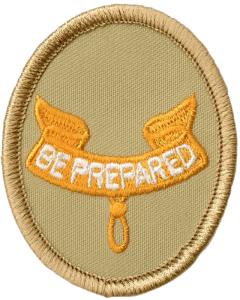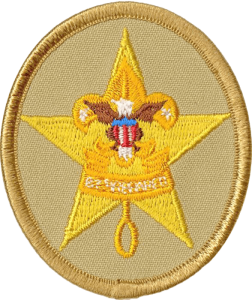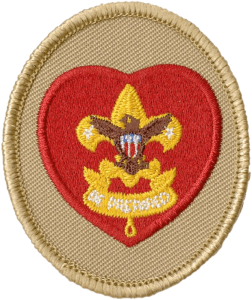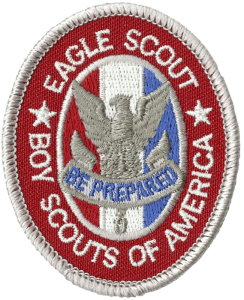Advancement
Scout Ranks

Scout
The Scout Rank covers the basic information you need to be a good scout. This includes learning the Scout Oath, Law, Motto, and Slogan. Understanding the premise of Scout Spirit, and learning the Scout sign, solute, and handshake. You can recite the Outdoor Code and explain the principles of Leave No Trace. You can recite the Pledge of Allegiance and explain its meaning. You understand the patrol method and how the troop operates. You can demonstrate basic knots and knife safety.
This rank should be achieved shortly after joining the troop. Youth can earn the Scout rank if they have completed the 5th grade and are at least 10 years old, or have earned the Arrow of Light Award and are at least 10 years old.
First Phase of Rank Advancement

Tenderfoot
Tenderfoot rank covers basic skills in camping, outdoor ethics, cooking, knots, first aid, nature, hiking, fitness, citizenship, and leadership. It is generally considered the beginning of the first phase of rank advancement in scouting consisting of Tenderfoot, Second Class, and First Class ranks. The requirements for these ranks can be worked on simultaneously, however, the ranks must be completed in order. Tenderfoot rank is typically achieved within the first year of scouting.

Second Class
Second Class continues the scouts development in the areas of camping, outdoor ethics, cooking, tools, navigation, nature, aquatics, first aid, fitness, citizenship, personal safety, and leadership. By achieving this rank a scout has shown improvement in their outdoor skills and is ready to take on more responsibility in the troop. Second class scouts may be expected to take on leadership positions through the troop, or guide younger scouts along the trail to first class.

First Class
First Class rank is generally considered the last rank in the first phase of rank advancement. As a First Class scout you will be expected to take on more leadership within your patrol and the troop. You have now gained considerable experience in the areas of camping, cooking, navigation, nature, aquatics, first aid, emergency preparedness, fitness, citizenship, leadership, and scout spirit. You are now ready to begin the second phase of rank advancement.
Second Phase of Rank Advancement

Star
Star rank is the first rank in the second phase of advancement. This begins a focus on active participation and leadership responsibilities in the troop. The Scouts are now required to complete various merit badges and lead through specific youth leadership positions for a specified amount of time.
Often scouts may take multiple years to reach the rank of Star. This depends on the scouts involvement and motivation, but typically a scout should targeting the rank of Star by their third or fourth year.

Life
Life rank is the second highest rank in scouting. A Life Scout is expected to have developed leadership skills and become a contributing member of the troop through various mentoring roles, leadership positions, and helping to set a good example of service and scout spirit for the rest of the troop. As a Life scout you will be viewed as a highly capable and accomplished scout and may be expected to serve in various leadership positions, including senior level youth leadership positions. You continue to gain specialized skills by acquiring additional merit badges, including various Eagle required merit badges.

Eagle
The Rank of Eagle Scout is the highest rank attainable in Scouting. Since the inception of Scouting in 1911, more than 2 million scouts have reached the rank of Eagle. The title of “Eagle Scout” is the only rank that can be carried into adult-hood and is a highly distinguished honor. Once an Eagle Scout, you are are always an Eagle Scout.
To earn the rank of Eagle a scout must earn 21 merit badges, with 11 merit badges being required for the rank of Eagle Scout. The scout must also demonstrate scout spirit, service, and leadership skills, including organizing an extensive service project known as an Eagle Project.
The Eagle Project will require the scout to effectively plan, organize, and communicate all aspects of the project. They will have to manage fundraising efforts to support the project. They must lead and manage other scouts and volunteers to fulfill the goals of the project, which must be presented and approved prior to commencing with the project. The project should aim to help a religious institution, school, or local community and must benefit an organization other than the Boy Scouts of America. This will require all the skills that they have obtained throughout their Scouting career. To learn more about the Eagle Scout Service Project, please review the Eagle Scout Service Project Workbook BSA publication No 512-927, or review the Guide to Advancement, topics 9.0.2.0 through 9.0.2.16.

Eagle Palm
After completing your Eagle Scout board of review and being recognized by the National Service Center as an Eagle Scout, a Scout will be entitled to receive an Eagle Palm for each additional five merit badges completed before their Eagle board of review beyond those required for Eagle. This applies to Eagle board of reviews on or after August 1, 2017.
Scouts who have earned the rank of Eagle Scout prior to their 18th birthday can also continue to work towards additional Eagle Palms until they reach the age of 18. You may only wear the proper combination of Palms for the number of merit badges you earned beyond the rank of Eagle. The Bronze Palm represents 5 merit badges, Gold represents 10, and Silver represents 15.
For example, if a scout has earned 45 merit badges prior to their Eagle board of review they would be entitled to receive one Silver Palm and one Bronze Palm to signify that they have earned 20 merit badges beyond the required 21 merit badges to earn Eagle. If they are still under the age of 18, they could continue to earn additional merit badges, while also fulfilling the requirements for Eagle Palms. After becoming an Eagle each new Palm requires at least three months between each Eagle Palm. If this scout earned one more merit badge, bringing his total to 46, participated in his troop for at least three months, showed leadership and scout spirit and participated in a Scoutmaster conference, then he could earn a Gold palm to replace the Bronze Palm signifying he has earned 25 merit badges beyond the required 21 for Eagle. If this scout earned an additional 5 merit badges and meet the additional requirements he could earn a second Silver Palm, replacing the Gold Palm and signifying that he has earned 30 merit badges beyond the required 21. The scout can continue to earn Palms up to his 18th birthday.

